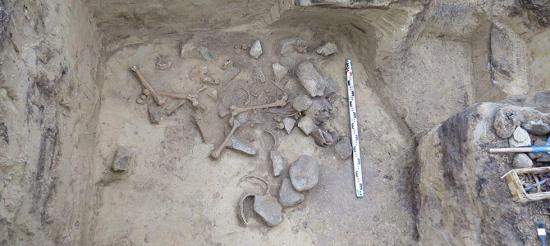Source -http://www.pasthorizonspr.com/index.php/archives/01/2014/unusual-zlockie-culture-burial-found-in-poland

A general view of the burial chamber. Image: M. Florek via PAP
Archaeologists have recently uncovered an unusual tomb belonging to the Złockie culture of the middle Neolithic era in Kleczanów, Poland. The skeleton is that of a partially disabled individual that archaeologists think may have been somone special within the group.
The discovery was made accidentally during ploughing in January 2014 and archaeologists called to the scene by the farmer began a detailed investigation.
“The burial consisted of a vertical shaft with a depth of more than 1.50 metres, which terminated in a chamber that was oval in plan” – explains Dr. Marek Florek the conservator on the project.
Possible ex-carnation
The flat base of the grave was lined with stone slabs and here the skeleton of the deceased, which initial examination suggests is female, was scattered across the surface. According to the archaeologists, the arrangement of skeletal remains in the grave indicates that the deceased was not buried immediately after death, but only after the decay of the soft tissues of the body, making it possible that some form of ex-carnation may have taken place.

Bone plaques – elements of a belt, an awl and flint arrowhead. Image: M. Florek via PAP
The deceased was accompanied by a small number of artefacts including animal bone plaques with perforations - possibly belt fittings.
In addition a triangular arrowhead of chocolate coloured flint was also placed in the grave along with a poorly preserved ceramic dish. The grave pit also contained a bone awl and a small piece of flint.
Unusual characteristics
The skelton, however did seem to have some unusual characteristics, and an initial examination of the bones revealed that the individual had one leg shorter than the other by at least 5 cm, and so would have had a pronounced limp. There are a number of lesions on the leg bones as well as on the skull – and here the sockets differ slightly in size and shape, and are offset, giving an asymmetrical face.

Dr. Florek reserves judgement on a fuller interpretation until the finds and osteological remains have been properly studied by anthropologists in the laboratory.
The archaeologists do note however that burials in the Złockie culture are usually full of grave goods, especially in ceramic plates and bowls as well as weapons, ornaments and tools of both stone and bone. Given the disturbed nature of the skeleton and the relative paucity of artefacts, they suspect the tomb has been robbed in antiquity.
Excavations conducted by Dr. Marek Florek with Monika Bajka of the Regional Museum in Sandomierz, will continue in this area during the summer in order to understand the location of the tomb and its relationship to other burials.
Source: PAP – Science and Scholarship in Poland www.naukawpolsce.pap.pl